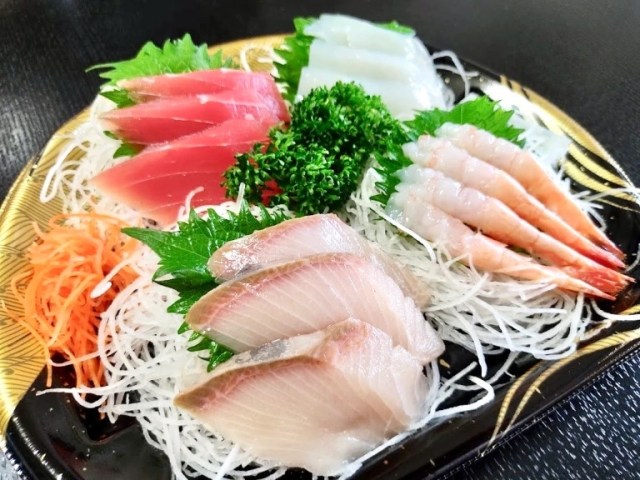
Taste-testing the effects of Pichit sheets.
You can find sashimi for sale at every supermarket in Japan, and the quality is usually pretty good. Not necessarily great, but good.
Great sashimi was exactly what our Japanese-language reporter Miho Kozuki was craving. Luckily, she had a secret weapon: Pichit.
OK, so maybe it’s not really a secret weapon, since the specially treated plastic wrap has been getting a lot of attention on social media recently. But the rumors of Pichit’s flavor-boosting powers had Miho feeling like she had a strong ally on her side as she pulled out a sheet.
According to its packaging, Pichit is supposed to condense the sashimi’s flavor and umami notes, while simultaneously eliminating any odors. It does this in two ways. First, the sheet draws moisture excess moisture out of whatever you’ve wrapped up in it. As we learned talking to a sashimi expert with decades of experience in the restaurant industry, if you have too much water, or worse, ice crystals, in a cut of fish, it’ll dilute the flavor and overly stiffen the texture. Second, Pichit is treated with starch syrup and seaweed extract, simulating the effects of kombujime, a method of preparing sashimi by sandwiching it between kelp leaves.
Using the sheet is a snap. First, Miho patted and wiped down some of her supermarket-bought sashimi with a paper towel.
Then she laid them out on the sheet…
…and folded the sheet over them. The Pichit sheet started drawing out moisture right away, forming a seal around the sashimi pieces as it did so.
Now Miho put the sashimi in her refrigerator while the sheet did its thing, and when she took it back out two and half hours later, it had been transformed!
For the sake of a taste-test comparison, Miho had put half of her sashimi into a Pichit sheet, and left the other half un-Pichit-ified, and they were now looking very different from each other.
▼ Left: Pichit sashimi
Right: Non-Pichit sashimi
▼ Pichit
▼ Non-Pichit
Since the package had said the sheets eliminate odors, Miho performed a sniff test first, but she didn’t really notice a difference between the two. Maybe that was because her sashimi was still pretty fresh from the market, and it didn’t really have any smell to it to begin with at this point.
But the flavor? There Miho noticed a big difference, and the Pichit-treated sashimi was far and away the better tasting. Again, that’s not to say the no-treated pieces were bad, but the ones that had spent time wrapped in the sheet were a lot more flavorful and didn’t have even a hint of sogginess to water down the taste. “It feels like they have twice as much umami as the regular pieces.” Miho says.
Prices for Pichit vary by store/seller, but Amazon has 32-sheet rolls for 2,048 yen (US$15.30). The only thing to be careful of is that because it removes moisture, Pichit isn’t such a good match for more succulent, extra-fatty types of sashimi, like otoro (extra-fatty tuna). But for things like maguro (regular tuna) or yellowtail, Miho thinks this is an affordable luxury upgrade that’s well worth it
Photos © SoraNews24
● Want to hear about SoraNews24’s latest articles as soon as they’re published? Follow us on Facebook and Twitter!
[ Read in Japanese ]

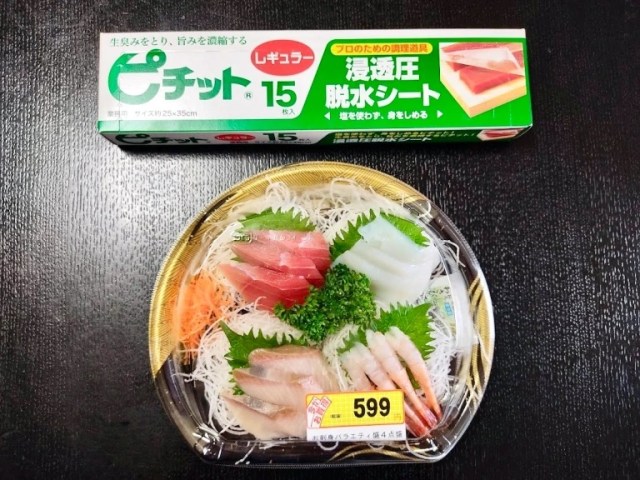
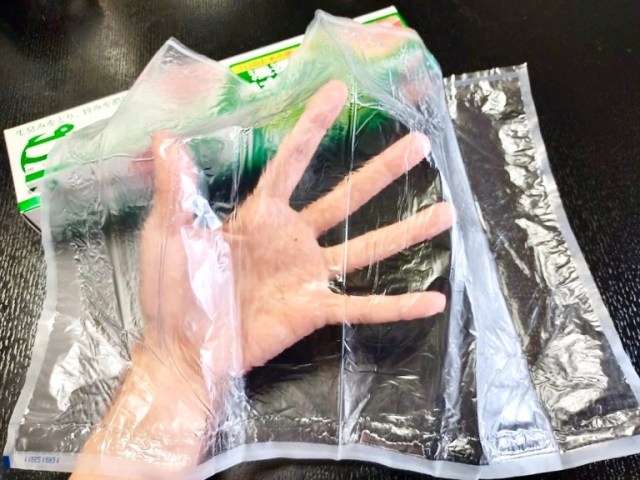
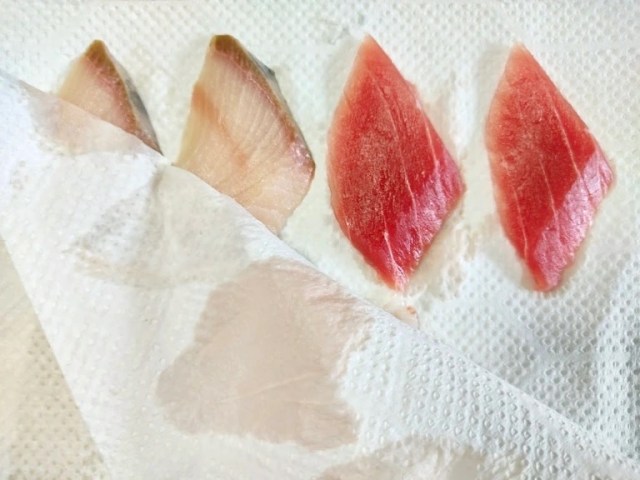
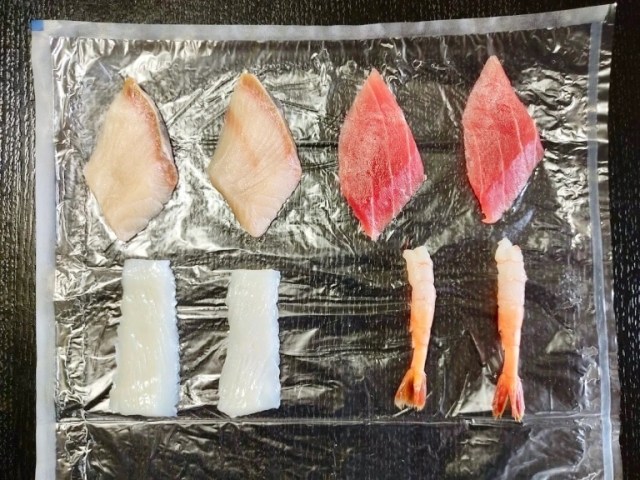

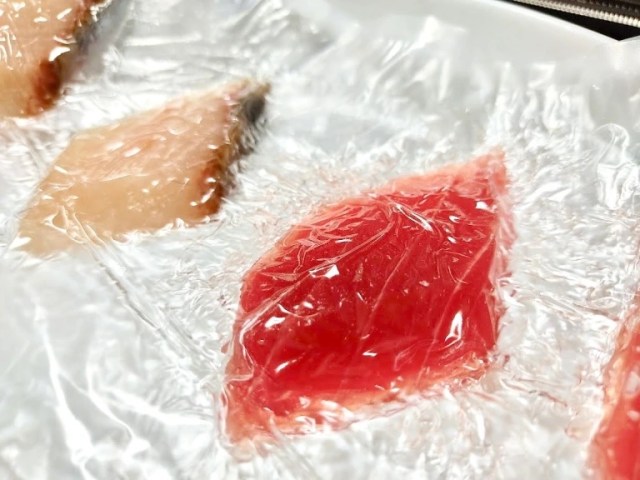
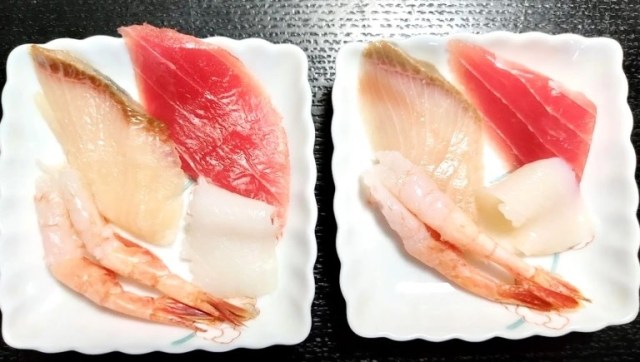
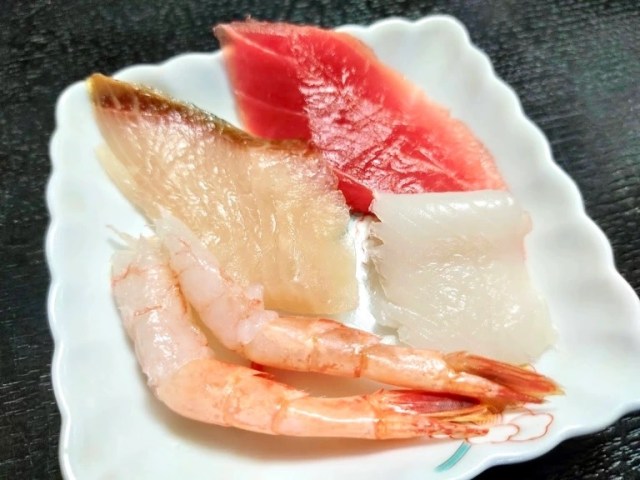
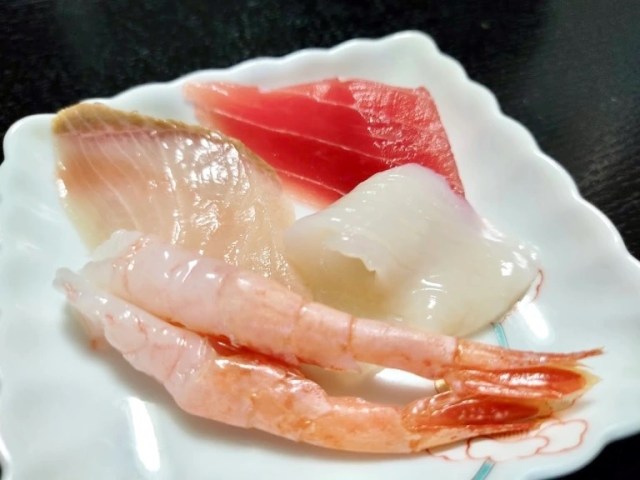
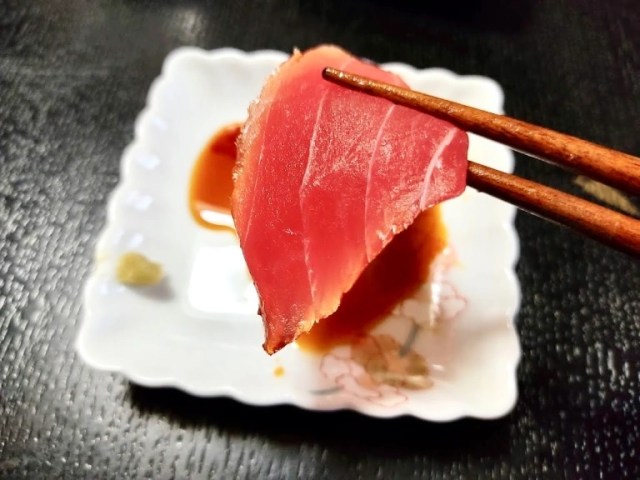
 We try Ajinomoto’s European Chicken Katsu Curry Style frozen gyoza that has no katsu in it
We try Ajinomoto’s European Chicken Katsu Curry Style frozen gyoza that has no katsu in it KFC releases an Otaku Burger…in Spain?!?
KFC releases an Otaku Burger…in Spain?!? We prepared our own delicious amberjack sashimi and realized how much money it saved us【Pics】
We prepared our own delicious amberjack sashimi and realized how much money it saved us【Pics】 Danish Radio Big Band welcomes new Japanese conductor with big band airport bash【Video】
Danish Radio Big Band welcomes new Japanese conductor with big band airport bash【Video】 The best and worst Japanese food for foreigners
The best and worst Japanese food for foreigners Foreigner’s request for help in Tokyo makes us sad for the state of society
Foreigner’s request for help in Tokyo makes us sad for the state of society Should you add tartar sauce to Japanese curry rice? CoCo Ichi makes diners an unusual offer
Should you add tartar sauce to Japanese curry rice? CoCo Ichi makes diners an unusual offer Japanese city loses residents’ personal data, which was on paper being transported on a windy day
Japanese city loses residents’ personal data, which was on paper being transported on a windy day Harajuku Station’s beautiful old wooden building is set to return, with a new complex around it
Harajuku Station’s beautiful old wooden building is set to return, with a new complex around it Seaside scenery, history, and so many desserts on Yokohama’s Akai Kutsu【Japan Loop Buses】
Seaside scenery, history, and so many desserts on Yokohama’s Akai Kutsu【Japan Loop Buses】 Red light district sushi restaurant in Tokyo shows us just how wrong we were about it
Red light district sushi restaurant in Tokyo shows us just how wrong we were about it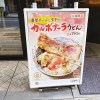 Limited-edition Carbonara Udon will anger noodle purists and pasta lovers 【Taste test】
Limited-edition Carbonara Udon will anger noodle purists and pasta lovers 【Taste test】 Akihabara pop-up shop sells goods made by Japanese prison inmates
Akihabara pop-up shop sells goods made by Japanese prison inmates Japan’s massive matcha parfait weighs 6 kilos, contains hidden surprises for anyone who eats it
Japan’s massive matcha parfait weighs 6 kilos, contains hidden surprises for anyone who eats it French Fries Bread in Tokyo’s Shibuya becomes a hit on social media
French Fries Bread in Tokyo’s Shibuya becomes a hit on social media McDonald’s new Happy Meals offer up cute and practical Sanrio lifestyle goods
McDonald’s new Happy Meals offer up cute and practical Sanrio lifestyle goods Japanese ramen restaurants under pressure from new yen banknotes
Japanese ramen restaurants under pressure from new yen banknotes Studio Ghibli releases new action figures featuring Nausicaä of the Valley of the Wind characters
Studio Ghibli releases new action figures featuring Nausicaä of the Valley of the Wind characters New private rooms on Tokaido Shinkansen change the way we travel from Tokyo to Kyoto
New private rooms on Tokaido Shinkansen change the way we travel from Tokyo to Kyoto Tokyo Tsukiji fish market site to be redeveloped with 50,000-seat stadium, hotel, shopping center
Tokyo Tsukiji fish market site to be redeveloped with 50,000-seat stadium, hotel, shopping center Beautiful Ghibli sealing wax kits let you create accessories and elegant letter decorations【Pics】
Beautiful Ghibli sealing wax kits let you create accessories and elegant letter decorations【Pics】 Studio Ghibli releases Kiki’s Delivery Service chocolate cake pouches in Japan
Studio Ghibli releases Kiki’s Delivery Service chocolate cake pouches in Japan New definition of “Japanese whiskey” goes into effect to prevent fakes from fooling overseas buyers
New definition of “Japanese whiskey” goes into effect to prevent fakes from fooling overseas buyers Our Japanese reporter visits Costco in the U.S., finds super American and very Japanese things
Our Japanese reporter visits Costco in the U.S., finds super American and very Japanese things All-you-can-drink Starbucks and amazing views part of Tokyo’s new 170 meter-high sky lounge
All-you-can-drink Starbucks and amazing views part of Tokyo’s new 170 meter-high sky lounge More foreign tourists than ever before in history visited Japan last month
More foreign tourists than ever before in history visited Japan last month New Pokémon cakes let you eat your way through Pikachu and all the Eevee evolutions
New Pokémon cakes let you eat your way through Pikachu and all the Eevee evolutions Disney princesses get official manga makeovers for Manga Princess Cafe opening in Tokyo
Disney princesses get official manga makeovers for Manga Princess Cafe opening in Tokyo Sales of Japan’s most convenient train ticket/shopping payment cards suspended indefinitely
Sales of Japan’s most convenient train ticket/shopping payment cards suspended indefinitely Sold-out Studio Ghibli desktop humidifiers are back so Totoro can help you through the dry season
Sold-out Studio Ghibli desktop humidifiers are back so Totoro can help you through the dry season Japanese government to make first change to romanization spelling rules since the 1950s
Japanese government to make first change to romanization spelling rules since the 1950s Ghibli founders Toshio Suzuki and Hayao Miyazaki contribute to Japanese whisky Totoro label design
Ghibli founders Toshio Suzuki and Hayao Miyazaki contribute to Japanese whisky Totoro label design Doraemon found buried at sea as scene from 1993 anime becomes real life【Photos】
Doraemon found buried at sea as scene from 1993 anime becomes real life【Photos】 Tokyo’s most famous Starbucks is closed
Tokyo’s most famous Starbucks is closed One Piece characters’ nationalities revealed, but fans have mixed opinions
One Piece characters’ nationalities revealed, but fans have mixed opinions We asked a Uniqlo employee what four things we should buy and their suggestions didn’t disappoint
We asked a Uniqlo employee what four things we should buy and their suggestions didn’t disappoint Princesses, fruits, and blacksmiths: Study reveals the 30 most unusual family names in Japan
Princesses, fruits, and blacksmiths: Study reveals the 30 most unusual family names in Japan Japan’s biggest ham company is making “tuna” that contains neither ham nor fish
Japan’s biggest ham company is making “tuna” that contains neither ham nor fish Japanese TV and movie star Mihiro reveals her secrets to younger looking skin
Japanese TV and movie star Mihiro reveals her secrets to younger looking skin Salmon sashimi noodles: Terrifying, mouthwatering, or both?【Photos】
Salmon sashimi noodles: Terrifying, mouthwatering, or both?【Photos】 Transparent soy sauce is a thing — we saw it, we tried it, we’re confused by it
Transparent soy sauce is a thing — we saw it, we tried it, we’re confused by it Trying some Umui sauces made only on a remote Japanese island with a population of 50【Taste test】
Trying some Umui sauces made only on a remote Japanese island with a population of 50【Taste test】 How to choose a great block of sashimi-grade tuna – 66-year maguro master shares his protips
How to choose a great block of sashimi-grade tuna – 66-year maguro master shares his protips Tottori airport serves crab soup from a faucet and… Dammit Seiji, put down that plastic bottle!
Tottori airport serves crab soup from a faucet and… Dammit Seiji, put down that plastic bottle! Japanese Americans tell STORIES FROM TOHOKU
Japanese Americans tell STORIES FROM TOHOKU Beef and sashimi in the same rice bowl: Brilliance or blasphemy? We find out【Taste test】
Beef and sashimi in the same rice bowl: Brilliance or blasphemy? We find out【Taste test】 Cat shaped seaweed can turn even the most unappetising meals into adorable works of art
Cat shaped seaweed can turn even the most unappetising meals into adorable works of art J-rock legend Gackt says he only eats the fish part of his sushi, never touches the rice
J-rock legend Gackt says he only eats the fish part of his sushi, never touches the rice Sashimi supplement pouches are here to help your body get the nutrients/sashimi it needs
Sashimi supplement pouches are here to help your body get the nutrients/sashimi it needs We visit a restaurant called ‘Otaku’ in France, eat some otaku sushi
We visit a restaurant called ‘Otaku’ in France, eat some otaku sushi Daiso’s Silicone Moisturizing Mask hydrates your face the smart way
Daiso’s Silicone Moisturizing Mask hydrates your face the smart way The secret, sudden sport Japanese cat owners play with their pets
The secret, sudden sport Japanese cat owners play with their pets Watch a sashimi master chef slice a fish like it’s no big deal【Video】
Watch a sashimi master chef slice a fish like it’s no big deal【Video】 Japan’s 10 best singing voices as chosen by people in the industry
Japan’s 10 best singing voices as chosen by people in the industry
Leave a Reply